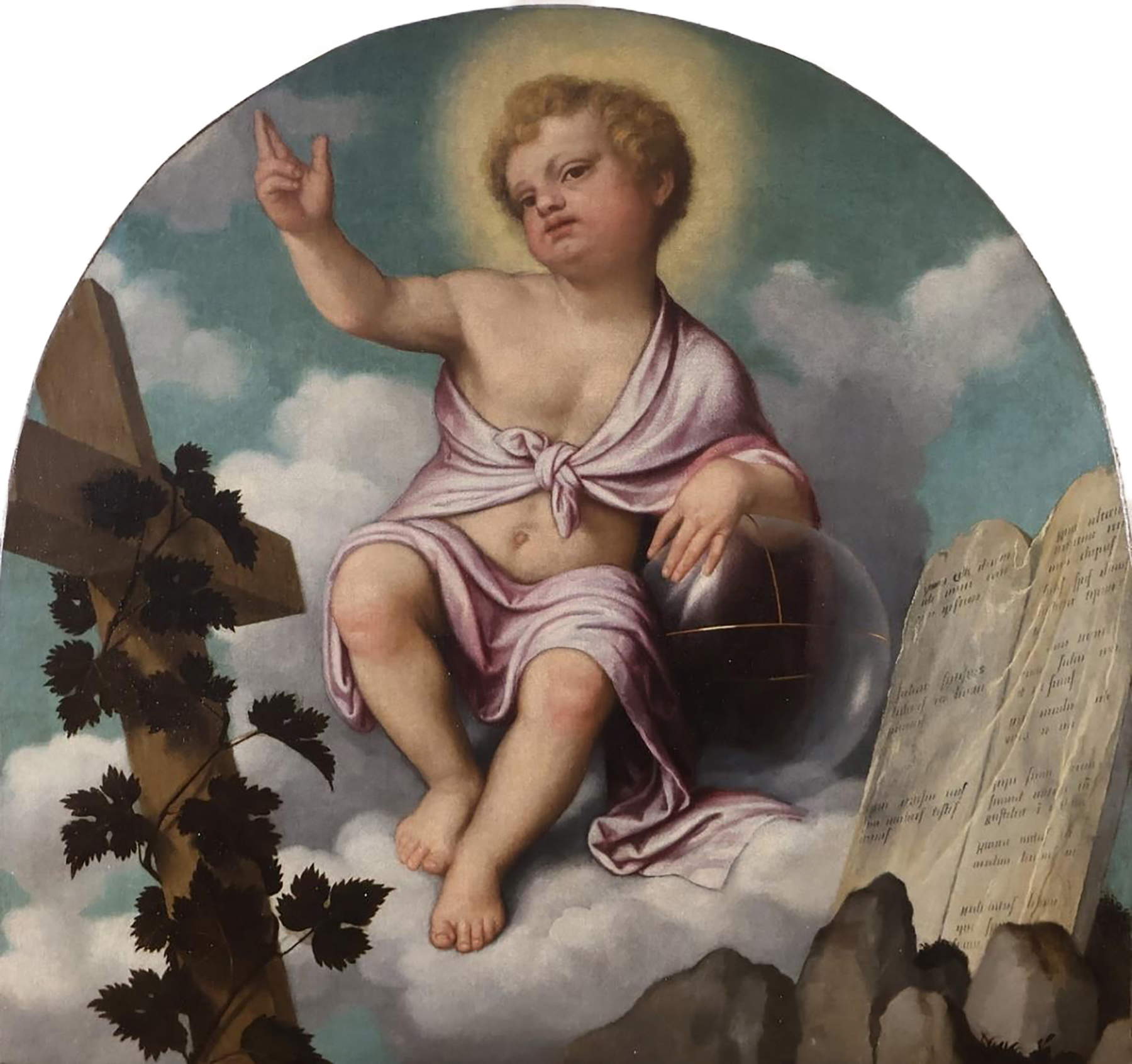An important unseen work of Renaissance painting is preparing to meet the public gaze for the first time. From April 16 to June 8, 2025, the rooms of the MarteS Museo d’Arte Sorlini in Calvagese della Riviera, in the province of Brescia, will host the painting The Child Redeemer between the Tables of the Law and the Cross, a work by Alessandro Bonvicino, known as il Moretto, among the greatest exponents of the mature Renaissance in the lands of the Serenissima. The exhibition represents an exceptional event not only because of the quality and rarity of the work, but also because it coincides with the 100th anniversary of the birth of Luciano Sorlini, entrepreneur and collector, founder of the museum that bears his name.
The painting, belonging to a private collection in Lombardy, has undergone a delicate and profound restoration, promoted by the Luciano Sorlini Foundation and curated by Luisa Marchetti within the MarteS museum spaces themselves. The work, attributable to the late production of the Brescian painter (in all likelihood to the 1640s or 1550s) was until now unknown to the general public. The restoration restored full legibility to the pictorial surface, bringing back the original chromatic freshness and ridding the canvas of oxidized varnishes, dust, old altered retouches and now-darkened restoration glues, which compromised its vision and formal balance.
“We are very proud to present to the public, for the first time,” says Stefano Sor lini, president of the Luciano Sorlini Foundation, "an extraordinary work such as Moretto’s Redentore fanciullo, restored thanks to the efforts of MarteS in a very special year for us, which celebrates the centenary of the birth of Luciano Sorlini, our founder. The Museum is not only a custodian of beauty, but also an active place of research, protection and enhancement of heritage. With this restoration we return not only the full legibility to a masterpiece, but also the possibility to rediscover a precious fragment of the artistic and spiritual history of our territory. I would like to thank the lenders and Alessandro Martoni for their valuable cooperation and trust placed in our institute."

At the center of the composition, striking in its iconography and spiritual intensity, stands the figure of the infant Jesus, depicted blessing the viewer. He is the Redemptor Mundi, the Savior of the world, recognizable also by the presence of the globe, a typical iconographic attribute of the Pantocrator. The figure of the little Christ is reclining on a group of clouds that alludes to the divine and glorious dimension of the scene. On the left, the Tablets of the Law emerge, veiled and resting on stones evoking Mount Sinai; on the right, stands the cross of Calvary, at the base of which climbs a Eucharistic vine branch, a powerful symbol of redemption and hope. A composition rich in symbolic elements and with a strong theological impact, which makes the work unique in the coeval painting scene.
The uniqueness of the subject and its symbolic charge are accompanied by a stylistic rendering marked by a careful naturalism, adhering to the dictates of post-Tridentine and anti-Lutheran spirituality that strongly influenced the artistic production of the time. Moretto, in this phase of his activity, confirmed himself as pictor religiosus among the most sensitive and aware, capable of translating the new reformist instances into images through a limpid, balanced, deeply pedagogical painting. The figure of Jesus, though hieratic, is rendered with delicacy and verisimilitude, as if to emphasize the link between human and divine, between transcendence and the immediate accessibility of the sacred.
Observations made during the restoration also revealed the work’s probable belonging to a larger composition. Indeed, signs of cuts and curtailments along the margins suggest that the painting may have originally been the cymatium of an altarpiece. This discovery only adds to the art-historical interest in the work, restoring it to a more complex original context and placing it in 16th-century liturgical compositional practice.
The restoration work addressed numerous critical issues that had accumulated over time. In addition to removing layers of dust and oxidized varnishes, the intervention removed previous restoration work dating back to 1980 and perhaps even older, carried out with oily materials that were poorly soluble and now deeply altered. In particular, it was necessary to work on dark pictorial revivals, overflowing stuccoes and deteriorated glues that were obscuring the original brilliance of the image. Thanks to the targeted action of cleaning and consolidation, today the surface appears compact and harmonious, and fully restores the beauty of Moretto’s painting.
The display of the work is part of a particularly significant year for the MarteS: in fact, 2025 marks the centenary of the birth of Luciano Sorlini, founder of the museum and a central figure in the promotion and conservation of Veneto and Lombard art. The exhibition of an unpublished masterpiece by Moretto, an artist among Sorlini’s most beloved and present in multiple examples in the permanent collection, is intended as an ideal tribute to his memory and vision.
 |
| An unpublished Moretto painting, the Redeemer as a child, returns to light after major restoration |
Warning: the translation into English of the original Italian article was created using automatic tools. We undertake to review all articles, but we do not guarantee the total absence of inaccuracies in the translation due to the program. You can find the original by clicking on the ITA button. If you find any mistake,please contact us.